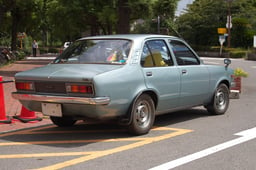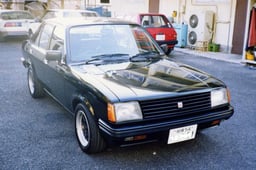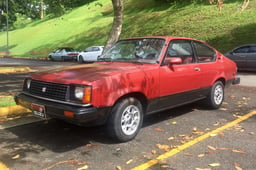Isuzu Gemini
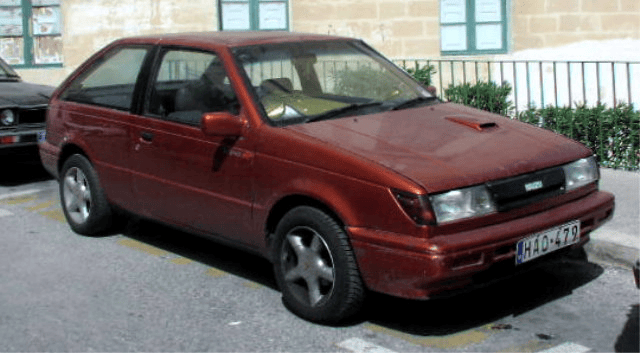
Isuzu Gemini

| Isuzu Gemini | |
|---|---|
| Overview | |
| Manufacturer | Isuzu(1974–1993)Honda(1993–2000) |
| Production | 1974–2000 (Japan) |
| Assembly | Fujisawa Plant,Fujisawa, Kanagawa,Japan(1974–2000) |
| Body and chassis | |
| Class | Subcompact car |
| Layout | FR layout(1974-1987)FF layout(1985-2000)Front engine,four-wheel drive(1990-1993) |
| Chronology | |
| Predecessor | Isuzu Bellett |
| First generation | |
| Overview | |
| Also called | |
| Production | November 1974–February 1987 |
| Body and chassis | |
| Body style | 2-doorcoupé4-doorsedan |
| Layout | FR layout |
| Platform | T-body |
| Related | |
| Powertrain | |
| Engine | |
| Dimensions | |
| Wheelbase | 2,405 mm (94.7 in) |
| Length | 4,135 mm (162.8 in) |
| Width | 1,570 mm (61.8 in) |
| Height | 1,365 mm (53.7 in) |
| Curb weight | 930 kg (2,050 lb) |
| Second generation | |
| Overview | |
| Also called | Isuzu I-MarkChevrolet SpectrumGeo SpectrumPontiac SunburstChevrolet GeminiHolden Gemini |
| Production | 1985–1990 |
| Designer | Giorgetto Giugiaro |
| Body and chassis | |
| Body style | 3-doorhatchbackcoupe4-doorsedan |
| Layout | FF layout |
| Platform | R-body |
| Powertrain | |
| Engine | |
| Transmission | 3-speedautomatic5-speedmanual5-speedsemi-automatic(NAVi5) |
| Dimensions | |
| Wheelbase | 2,400 mm (94.5 in) |
| Length | I-Mark Hatchback Coupe: 4,011 mm (157.9 in)I-Mark Sedan: 4,082 mm (160.7 in)Spectrum Hatchback Coupe: 3,998 mm (157.4 in)Spectrum Sedan: 4,069 mm (160.2 in) |
| Width | I-Mark: 1,613 mm (63.5 in)Spectrum: 1,615 mm (63.6 in) |
| Height | I-Mark: 1,374 mm (54.1 in)Spectrum: 1,321 mm (52.0 in) |
| Chronology | |
| Predecessor | Chevrolet Chevette(Spectrum)Opel Isuzu(I-Mark)Pontiac Acadian(Sunburst) |
| Successor | Isuzu Stylus(I-Mark)Passport Optima(Sunburst)Geo Storm(Spectrum, hatchback)Geo Prizm(Spectrum, sedan) |
| Third generation | |
| Overview | |
| Also called | Isuzu Stylus |
| Production | 1990–1993 |
| Body and chassis | |
| Body style | 2-doorcoupe3-doorhatchback4-doorsedan |
| Layout | Front engine,front-wheel drive/four-wheel drive |
| Platform | R-body |
| Related | Geo StormIsuzu ImpulseAsüna Sunfire |
| Powertrain | |
| Engine | 1.5 L4XC11.5 L4XC1-TturboI4 (JT150)1.6 L4XE1DOHCI4 (JT190)1.8 L4XF1DOHCI41.7 L4EC1diesel/TDI4 (JT600) |
| Transmission | 3-speedautomatic5-speedmanual |
| Dimensions | |
| Wheelbase | 2,451 mm (96.5 in) |
| Length | 4,191 mm (165.0 in) |
| Width | 1,679 mm (66.1 in) 1,694 mm (66.7 in) (4WD sedan) |
| Height | 1,374 mm (54.1 in) |
| Fourth generation | |
| Overview | |
| Production | 1993–1996 |
| Body and chassis | |
| Body style | 4-doorsedan |
| Layout | FF layout |
| Related | Honda CivicHonda DomaniHonda Integra SJRover 400 |
| Fifth generation | |
| Overview | |
| Also called | Honda DomaniAcura EL |
| Production | 1997–2000 |
| Body and chassis | |
| Body style | 4-doorsedan |
| Layout | FF layout |
| Related | |
| Dimensions | |
| Wheelbase | 103.1 in (2,619 mm) |
The Isuzu Gemini was a subcompact car that was produced by the Japanese automaker Isuzu from 1974 to 2000. The same basic product was built and/or sold under several other names, sometimes by other General Motors brands, in various markets around the world. While the first generation was of a rear-wheel drive design, later versions were all front-wheel-drive. The last two generations were no more than badge-engineered Honda Domani until the name was retired in 2000.
| Isuzu Gemini | |
|---|---|
| Overview | |
| Manufacturer | Isuzu(1974–1993)Honda(1993–2000) |
| Production | 1974–2000 (Japan) |
| Assembly | Fujisawa Plant,Fujisawa, Kanagawa,Japan(1974–2000) |
| Body and chassis | |
| Class | Subcompact car |
| Layout | FR layout(1974-1987)FF layout(1985-2000)Front engine,four-wheel drive(1990-1993) |
| Chronology | |
| Predecessor | Isuzu Bellett |
| First generation | |
| Overview | |
| Also called | |
| Production | November 1974–February 1987 |
| Body and chassis | |
| Body style | 2-doorcoupé4-doorsedan |
| Layout | FR layout |
| Platform | T-body |
| Related | |
| Powertrain | |
| Engine | |
| Dimensions | |
| Wheelbase | 2,405 mm (94.7 in) |
| Length | 4,135 mm (162.8 in) |
| Width | 1,570 mm (61.8 in) |
| Height | 1,365 mm (53.7 in) |
| Curb weight | 930 kg (2,050 lb) |
| Second generation | |
| Overview | |
| Also called | Isuzu I-MarkChevrolet SpectrumGeo SpectrumPontiac SunburstChevrolet GeminiHolden Gemini |
| Production | 1985–1990 |
| Designer | Giorgetto Giugiaro |
| Body and chassis | |
| Body style | 3-doorhatchbackcoupe4-doorsedan |
| Layout | FF layout |
| Platform | R-body |
| Powertrain | |
| Engine | |
| Transmission | 3-speedautomatic5-speedmanual5-speedsemi-automatic(NAVi5) |
| Dimensions | |
| Wheelbase | 2,400 mm (94.5 in) |
| Length | I-Mark Hatchback Coupe: 4,011 mm (157.9 in)I-Mark Sedan: 4,082 mm (160.7 in)Spectrum Hatchback Coupe: 3,998 mm (157.4 in)Spectrum Sedan: 4,069 mm (160.2 in) |
| Width | I-Mark: 1,613 mm (63.5 in)Spectrum: 1,615 mm (63.6 in) |
| Height | I-Mark: 1,374 mm (54.1 in)Spectrum: 1,321 mm (52.0 in) |
| Chronology | |
| Predecessor | Chevrolet Chevette(Spectrum)Opel Isuzu(I-Mark)Pontiac Acadian(Sunburst) |
| Successor | Isuzu Stylus(I-Mark)Passport Optima(Sunburst)Geo Storm(Spectrum, hatchback)Geo Prizm(Spectrum, sedan) |
| Third generation | |
| Overview | |
| Also called | Isuzu Stylus |
| Production | 1990–1993 |
| Body and chassis | |
| Body style | 2-doorcoupe3-doorhatchback4-doorsedan |
| Layout | Front engine,front-wheel drive/four-wheel drive |
| Platform | R-body |
| Related | Geo StormIsuzu ImpulseAsüna Sunfire |
| Powertrain | |
| Engine | 1.5 L4XC11.5 L4XC1-TturboI4 (JT150)1.6 L4XE1DOHCI4 (JT190)1.8 L4XF1DOHCI41.7 L4EC1diesel/TDI4 (JT600) |
| Transmission | 3-speedautomatic5-speedmanual |
| Dimensions | |
| Wheelbase | 2,451 mm (96.5 in) |
| Length | 4,191 mm (165.0 in) |
| Width | 1,679 mm (66.1 in) 1,694 mm (66.7 in) (4WD sedan) |
| Height | 1,374 mm (54.1 in) |
| Fourth generation | |
| Overview | |
| Production | 1993–1996 |
| Body and chassis | |
| Body style | 4-doorsedan |
| Layout | FF layout |
| Related | Honda CivicHonda DomaniHonda Integra SJRover 400 |
| Fifth generation | |
| Overview | |
| Also called | Honda DomaniAcura EL |
| Production | 1997–2000 |
| Body and chassis | |
| Body style | 4-doorsedan |
| Layout | FF layout |
| Related | |
| Dimensions | |
| Wheelbase | 103.1 in (2,619 mm) |
First generation (1974-1987)

1979 facelift Holden Gemini (Holden built and badged version for the Australian market)
The first Gemini was the Bellett Gemini, first seen in November 1974. It was based on the third-generation Opel Kadett C on the General Motors T-car platform and came in four-door sedan and two-door coupe body styles. The chassis code was PF50, although the later 1.8-liter versions were called PF60 and the diesels PFD60.[1]
In June 1977 the Gemini received its first, light, facelift.
The bigger 1817 cc G180 series engine became available, fitted with rectangular headlights rather than the round units used on the 1600.
This model offered 110 PS (81 kW), although this output dropped to 105 PS (77 kW) if an automatic transmission was fitted.[2] In November of the same year the 1600 was updated, now with square headlights and an engine with the I·CAS oxidation catalyst ("Isuzu Clean Air System") which could manage the 1978 emissions standards.[3] One year later the Gemini 1800's engine was also upgraded to meet the 1978 emissions standards.[3] Power remained unchanged, and the automatic now offered the same power as cars with manual transmission.[5] The ignition system was now of a transistor less type, and the trunk lid was now opened remotely (not added to the Gemini 1600 until the end of December). The Gemini Black and 1800 Minx were also added, the Minx with a two-tone paintjob and the Black with black paintwork and more sporty yet comfortable equipment including alloy wheels.[3]
In June 1979,[1] the Gemini received a new slant nose with rectangular headlights and a redesigned rear end. The changes were actually more comprehensive than that, also including a redesigned (longer) engine bay and a wider radiator opening for two new engines added in November (the twin cam G180W and the new 4FB1 diesel) which both required wider radiators for more air for cooling.[6]
In Japan, sports models were available originally with the "ZZ" name. Later, ZZ/L (1980), ZZ/R (1981), ZZ/T, and ZZ/E models were added. These were equipped with an Isuzu G180W 8-valve DOHC 1.8-liter engine, most commonly fuel-injected, producing 130 PS (96 kW) at 6400 rpm. These models also came with a shortened remote throw manual shift lever and optional factory LSD differential.[7] There was also a mildly sporting model of the OHC 1800, called the LS/G.
In October 1982 a version of the diesel with Bosch VE electronic fuel injection was also added; this provided 8% more power than the regular version (66 versus 61 PS) and was fitted to the LT-E and LJ-E models.
For those who wanted more, a 73 PS (54 kW) turbo diesel appeared a month later.
Also featuring electronic fuel injection, this model also received a standard rear anti-roll bar.
Counterintuitively, the two more powerful diesels were never available with the coupé bodywork.[8]
The Gemini was complemented in 1981 by the Giugiaro-designed coupé Isuzu Piazza, based on the Gemini's platform, which was introduced in the United States in 1983 as the Isuzu Impulse and in Australia in 1986 as the Holden Piazza. After the front-wheel-drive second generation Gemini appeared in early 1985, the old rear-wheel drive version nonetheless continued to be built. The coupé model was discontinued, and a slimmed down sedan range (including the ZZ and diesel models) continued to be available. This diminished range was produced until February 1987, when the rear-wheel drive Gemini was laid to rest after 768,537 had been built.
In other markets

1976 Opel by Isuzu, a rebadging for the US
- North America
The North American market version was originally sold as the "Opel by Isuzu" and then the Buick Opel (sometimes referred to as the "Buick Isuzu Opel").
It first appeared in late 1975, for the 1976 model year, and replaced the German-built Kadett which had become too expensive as a result of the weakening dollar and rising costs in Germany.[9]Gene]]Road & Track decried the switch, stating that the Isuzu felt "built to a price" and that unlike the real Opel, it was "one of our least favorite cars."[[10]](https://openlibrary.org/search?q= [[CITE|10|https://openlibrary.org/search?q=*Road%20%26%20Track's%20Road%20Test%20Annual%20%26%20Buyer's%20Guide%201) its changes being limited to the paint, different steel wheels, sporty mirrors, and a spoiler. For 1979 the car received a light cosmetic update with ribbed velour trim, a few new paint options, and rectangular headlights.[10]
For the 1981 model year, the "Buick Opel" metamorphosed into the "Isuzu I-Mark".[11]*Standard%20Catalog%20of%20Im]]The diesel engine was available in the I-Mark, but the standard engine was a 78 hp (58 kW) (SAE net) version of the 1.8 litre G180Z engine.[12] dywork with either engine, in Deluxe or fully equipped LS (added for the 1982 model year) trim. A five-speed manual or a three-speed automatic were on offer. There was also a base diesel-engined coupé on offer, with a four-speed manual transmission only.[13] The diesel gradually lost sales after USA's brief love affair with the diesel car came to an end in the early eighties, and eventually it was only available in a single coupé version.[11]Standard%20Catalog%20of%20Im]]For 1985, the rear-wheel-drive I-Mark's last year, only the Deluxe sedan version with a gasoline engine remained available.[[14]](https://openlibrary.org/search?q= [[CITE|14|https://openlibrary.org/search?q=1985%20Isuzu%20Models%20Announced%20%28Press%20Release%29%2C%20Whi)
- Australasia
In addition to sedan and coupé models, Holden in Australia produced the Gemini as a three-door station wagon and three-door panel van, which were derived from the Opel Kadett C Caravan and Vauxhall Chevette wagon, with Isuzu Gemini front panels. The panel van's side panels came from the Bedford Chevanne. The Australian Holden Gemini was fitted with an Isuzu G161Z petrol engine, although 1979 and later models were available with a 1.8-litre 8-valve SOHC diesel engine (4FB1). The more common G161Z was a 1.6-liter 8-valve SOHC fed by a Nikki carburettor. The Holden Gemini was Wheels magazine's Car of the Year for 1975.
- Other markets
In Europe, the Gemini was equipped with the 1.6-liter engine which produced 68 PS (50 kW) DIN there; the discrepancy in stated power (down 32 percent) may have been entirely due to the differences to the SAE (gross) measuring system used on Japanese market cars.
Isuzu Gemini was also sold in South Korea asSaehan Gemini, whose manufacturer became Daewoo Motors in 1982. It then became Daewoo Maepsy after 1982 and remained on sale (later as the Maepsy-Na after a facelift) until it was replaced by Daewoo LeMans in 1986.
Sold as:
1975–1984 -Holden Gemini - Australia (1977–1984 in New Zealand initially badged as an Isuzu, as the brand had already been established by the earlier Bellett)
1975–1983 - Opel Gemini - Malaysia, Thailand
1976–1979 - Opel Isuzu/Buick Opel - United States
1977–1982 -Saehan Gemini - South Korea ("Saehan Bird" in the export)
1982–1986 - Saehan/Daewoo Maepsy/Maepsy-Na - South Korea, Saehan Maepsy before
1982–1988 - Saehan/Daewoo Max - pickup version, South Korea
1981–1984 - Isuzu I-Mark
Second generation (1985-1990)

Pre-facelift Gemini FF (JT150)
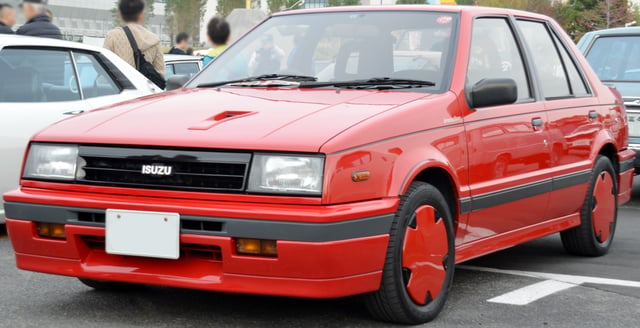
Pre-facelift Gemini Irmscher (JT150)

1985–1987 Holden Gemini (RB) SL/X

1988-89 Isuzu I-Mark hatchback coupe (North America)

1989 Chevrolet/Geo Spectrum

Isuzu 4XE1
General Motors sought a replacement for their world car T-body Kadett / Gemini, and this time, instead of building one design on several continents, they decided to build a world car in one location and export it to several continents. As a considerable portion of the T-body manufacturing had been turned over to Isuzu in Japan for economic reasons, so would the manufacturing of the replacement. In 1984, Isuzu again commissioned Giorgetto Giugiaro who was responsible for the 117 Coupé and the Piazza. This time, he was to design an economy car on the new front-wheel drive R-body platform. The R-body featured a MacPherson strut front suspension and beam axle rear suspension, which foreshadowed most of GM's offerings through their current model lineup. Giugiaro's design followed the Piazza design very closely in shape and detail, though the proportions made the Gemini appear shorter and taller in its three-door version, and a four-door sedan (notch back) was also designed.
Unfortunately for everyone involved, Isuzu presented the designs to GM prior to freezing them, and GM ordered a number of detail changes to them without ever consulting the designer, Giugiaro, which was taken as an insult, and ended the long relationship between the noted Italian designer and Japan's second oldest car builder.
The insult was serious enough to Giugiaro that he denied the design was his until a decade after the vehicle went out of production.
The R-body Gemini was introduced in May 1985 as the Gemini FF (after it had already gone on sale as a Chevrolet in the United States), with an all-new line of engines. In Japan, originally with chassis code JT150, it was available with a carburetted 1.5-liter SOHC engine. An also newly developed 1.5-liter inline four diesel engine (JT600) was added to the lineup in November. At the other end of the lineup, a 120 PS (88 kW) fuel-injected and turbocharged version of the 1.5-liter 4XB1 engine ("Irmscher") was added in May 1986. Originally, the transmission started out with a choice of a 5-speed manual or a 3-speed automatic, but NAVi5, an automated manual transmission, was added in 1986.
The FF Gemini underwent a facelift in February 1987, receiving a more aggressive front styling with wraparound headlight as well as other minor changes.
At the same time the "FF" moniker was dropped, as parallel production of the preceding RWD Gemini came to an end.
In March 1987 the Gemini saw its European premier, at the Geneva Salon. European sales of the already somewhat dated Gemini were disappointing, and Isuzu soon withdrew from the European passenger car market entirely.
A 1.6-liter DOHC engine with 135 PS (99 kW) was introduced in February 1988. Export versions were also available with a smaller 1.3-liter four to suit taxation systems based on displacement.[15]Quattroruote]]This offered 72 PS (53 kW), while export specification 1.5s had 76 PS (56 kW) on tap and the naturally aspirated diesel offered 52 PS (38 kW) outside Japan.[[16]](https://openlibrary.org/search?q=Ruiz%2C%20Marco%20%281986%29.%20 [[CITE|16|https://openlibrary.org/search?q=Ruiz%2C%20Marco%20%281986%29.%20*'The%20Complete%20History%20of%20the%20) Trim levels were widely varied, from basic models ("C/C" in Japan, "LT" in general export markets, and "S" in the US) to Irmscher, ZZ, and Lotus Tuned versions, and plenty of optional equipment and dealer options were available.
North America
In the US, the vehicle was available from Chevrolet (and later Geo) as the Spectrum, or from Isuzu themselves, as the I-Mark. GM's Pontiac division sold the I-Mark as the Pontiac Sunburst in Canada from 1985 to 1988. Sales were limited to coastal markets initially, as import quotas restricted the number of cars General Motors could sell in the United States.[17] The Spectrum was presented at the end of November 1984, with cars already on sale in 16 eastern states. Isuzu's own I-Mark went on sale during the 1985 model year.[18] Due to the quotas, only 29,500 cars were available the first model year, about a quarter of what GM had hoped to be able to sell.[19] 1985 and 1986 models featured a unique eggcrate grille flanked by single square sealed-beam headlights.
GM Canada announced that the Sunburst's replacement would be the Passport Optima in 1989.
For GM, this was an entry level vehicle to attract young buyers and to compete with Japanese midsize cars in the US market.
Chevrolet's Spectrum lacked many of the options and equipment of the I-Mark, though both were available with the 70 hp (52 kW) 1.5-liter SOHC non-turbo and 110 hp (82 kW) turbo engines, but neither diesel engines nor NAVi5 were offered in the US.
The turbo model I-Mark was called the RS model in 1988 and then changed to the LS model in 1989.
The I-Mark was available with the 125 hp (93 kW) 1.6-liter DOHC engine in 1989 only, as the RS model.
In 1988 and 1989, the LS and RS models were offered with Lotus Tuned Suspension, the sportier suspension featuring more rigid dampers, alternate spring rates, and bigger sway bars.
Sold as:
1985–1989 Isuzu I-Mark - United States, Canada
1985–1990 Isuzu Gemini - Japan, Europe, and Central America
1984–1988 Chevrolet Spectrum - United States & Canada
1988–1989 Geo Spectrum - United States
1985–1989 Pontiac Sunburst - Canada
1985–1987 Holden Gemini - Australia and New Zealand
1985–1990 Chevrolet Gemini - Chile and Argentina
Third generation (1990-1993)

1991–1993 Isuzu Gemini Hatchback
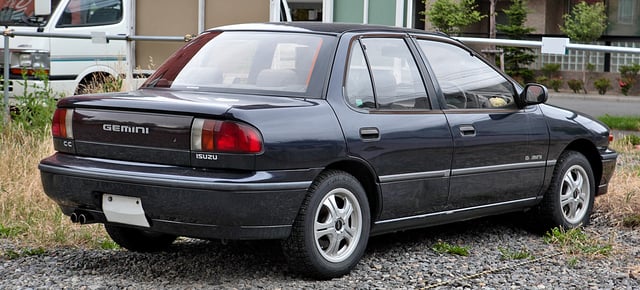
1991–1993 Isuzu Gemini sedan
The Gemini was redesigned for 1990, and the coupé version was now renamed the Gemini Coupé. The last models were produced in 1993. The third generation sedan appeared in March 1990. Body size was wider than the previous generation.
The Isuzu Gemini Coupé was the basis for the Isuzu Impulse and Geo Storm in the United States and Canada, and for the Asüna Sunfire which was sold in the Canadian market for the 1993 model year only.
A 4-door sedan with similar mechanical components was sold as the Isuzu Stylus in the United States and Canada.
The Geo versions lacked some of the more expensive and advanced features of the Isuzu (and Asüna) versions.
All these names were used on the last of the Geminis — Isuzu Impulse, Isuzu Piazza, Isuzu Gemini MkII, Isuzu Stylus, and Asüna Sunfire.
The series name was called the type JT641S, the type JT641F, and the 4WD car is the same type JT191S.
The car is 1700 cc turbo diesel type JT191F, 4WD gasoline turbo cars with 1600 cc DOHC gasoline type intercooler JT151F, the car is 1500 cc, and 1600 cc DOHC gasoline.
The top-line Stylus RS model had either a 1.6 L naturally aspirated engine (1991) or the 1.8 L naturally aspirated engine (1992).
The higher trim level packages offered "ZZ handling by Lotus" and "specification Irmscher" as the performance models in the lineup, but was carryovered from previous generations.
The top model was the "Irmscher-R" JT191S type, equipped with a high-power turbocharged engine and full-time 4WD.
The suspension packages that were installed on the second generation Isuzu Piazza were also shared on the Gemini sold in Japan, including the four-wheel steering setup.
It was originally intended to be a four-door sedan, and coupe from September 1990, three-door hatchback has been added in March 1991 later.
Sedan sales has been started from December 1990 under the name "STYLUS" in the North American market.
As the recession began to take hold in Japan, known as the "bubble economy", Isuzu was affected particularly hard, and after a corporate restructuring, Isuzu decided to abandon passenger car production and focus on commercial truck and SUV production, as the Isuzu Trooper and the Isuzu Rodeo found many buyers internationally, with badge engineered versions sold in Europe as Vauxhall/Opel Frontera (Rodeo) and Vauxhall/Opel Monterey and Holden Frontera (Rodeo) and Holden Jackaroo/Monterey (Trooper) in Australia with assistance from General Motors, and Honda also selling the Rodeo as Honda Passport and the Trooper as Honda Horizon (in Japan) and the Acura SLX (in the United States).[20]
The total production volume of vehicles was 406,625 units at the end of the third generation (from HQ Isuzu), with 17,754 units sold in the United States (from Ward's Automotive Yearbook).
Fourth generation (1993-1996)
Isuzu halted production of the Gemini and replaced it with a rebadged version of the Honda Domani. It was only available with the four-door sedan bodystyle and a limited number of engines; the Domani also came as a five-door hatchback.
Fifth generation (1997-2000)
The fifth generation Gemini was a rebadged second generation Honda Domani sedan, a car which was also marketed as a Civic in Europe. Production of this model ceased in 2000. As usual, the Gemini was available in a much more limited lineup than that of the related Honda version, with only one bodystyle and either a 1.5 or a 1.6 litre engine.
Safety
In Australia, the 1982–1984 Holden Gemini was assessed in the Used Car Safety Ratings 2006 as providing "significantly worse than average" protection for its occupants in the event of a crash.[21]
Police use
The Singapore Police Force previously used the Isuzu Gemini Fast Response Cars (FRCs) from 1991 until 1995 until they were phased out and replaced by the Subaru Impreza police cars.
Related information
Isuzu Geminis and I-Marks were the most popular taxicab models in the Philippines in the 80s and early 90s. Models were phased out and gradually replaced with newer models from Toyota and Nissan.

